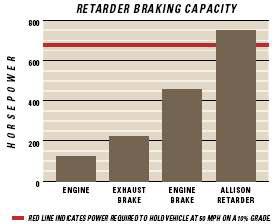BRAKING THROUGH RESISTANCE.
Allison’s hydraulic retarder is basically a vaned flywheel in the transmission housing. The transmission directs oil into the retarder housing to absorb the vehicle’s energy through the drive shaft. The absorbed energy is converted to heat and dissipated through the vehicle’s cooling system. Resistance to the flywheel, augmented by stators on the inside of the housing, delivers braking power to the driving wheels. More oil in the housing means stronger braking. And since there’s no mechanical friction or wear to shock the drive train, you’ll have better control of maintenance costs, too.
Allison models are available with output retarders mounted on the output shaft, behind the gearing. They generate the greatest braking at high driveshaft RPM and work independently of engine speed or gear ratio.
MCI Service Information – April 2003

Allison™ Transmission Retarder Operation
This tip is being written as an informational tool for the correct operation of Allison WTEC transmissions equipped with hydraulic retarders. When used properly, this feature assists in the deceleration of the coach which also reduces the wear of brakes/brake shoes.
The transmission retarder is enabled by a switch on the driver’s console. When enabled, the transmission retarder is activated by two different methods; either with the application of the service brake pedal or by releasing the throttle pedal. A joystick on the driver’s console selects the amount of retardation. Typically, retardation increases as the lever are moved to the rearmost position, but some coaches have been set up with maximum retardation in the foremost position, so refer to the decal next to the joystick for the specific retarder operation. Inside the air brake valve are two switches that activate the retarder as the brake pedal is applied. Retardation increases with brake pedal travel.
For smooth operation and minimal heat generation, the suggested method of operation is an initial application of the retarder in the lowest joystick position, and slowly moving the joystick towards the maximum retardation position as increased deceleration is required.
An Allison transmission retarder provides secondary vehicle braking via the transmission. Transmission retarders are usually more effective than engine brakes at lower RPMs; at higher RPMs, they tend to even out. Transmission retarders generate a lot of heat and their maximum braking horsepower is usually limited by the RV’s cooling system. Transmission retarders are priced at a premium to engine brakes so they tend to be very costly. Allison Transmission
Imagine standing over a 55 gal drum with a boat oar, and you’re stirring the oar around and around. When there’s only air in the drum, it’s easy to move the oar. Now, fill the drum with a viscous fluid like oil, and try stirring. Not so easy, now. The retarder works the same way. through a mechanical connection, the drive wheels are trying to turn a bunch of little paddles in a fluid. Since energy can be neither lost nor gained, rolling motion is converted to heat through shear, and dissipated into the air. Steven Hill
The hydraulic retarder is a most simple device, and has only one moving part — a rotor or “paddlewheel.” The truck wheels turn the rotor through the transmission. The rotor throws the oil in the rotor cavity against the fixed stator vanes, which resist the oil flow. This makes it harder for the rotor to turn and correspondingly makes it harder for the truck wheels to turn, thus slowing the vehicle. The oil does all the “braking” work, absorbing the heat generated by the braking action. The oil is circulated to the heat exchanger. When retarder action is not called for, the valve is closed, the oil is evacuated from the cavity, and there is no power absorption in the retarder. Bear in mind the hydraulic retarder is what the name implies — a retarder, and will not bring the vehicle to a complete stop, but only retard its forward motion. Since the capacity of the retarder or its retarding action is directly related to its RPM, it will be most effective at higher engine and vehicle speeds.
Retarder Operation on a Foretravel
Retarder switch on, Joystick in zero position (fully forward on my coach), let off the power, no retard.
Retarder switch on, Joystick in any position other than zero, let off the power, the retard to match the Joystick position comes on.
Retarder switch on, Joystick in zero position, let off the power and lightly press the brake, 30% retard engaged. Press harder, 66% retard engaged; press even harder, 100% retard engaged.
I believe the light pressure on the brake that provides 2 psi in the chamber calls for 30%, pressing harder to achieve 7 psi in the chamber results in 66% and pressing to increase to 10+psi results in 100% retard. James Triana